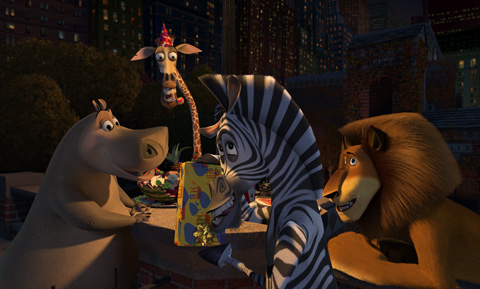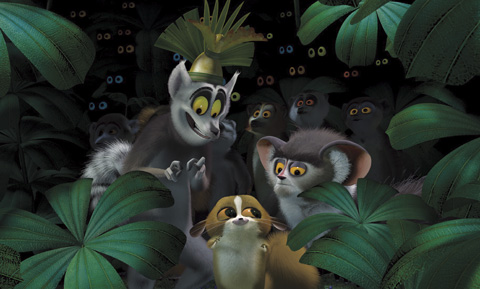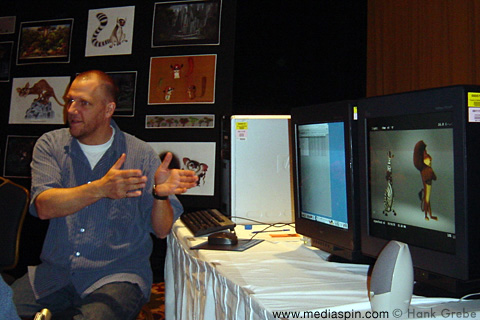Daily ArchiveSaturday, May 7th, 2005
Media &Movie TV DVD Review &Technology SpinMeister on 07 May 2005
Madagascar: Toons Gone Wild

I have an unusual perspective on DreamWorks Animation’s new animated feature, Madagascar, since I was working at PDI/DreamWorks on Shrek 2 while Madagascar was in story and visual development stages.
As Shrek 2 was nearing completion in early 2003, word was circulating around the PDI/DreamWorks production cubicles that Jeffrey Katzenberg, the CEO of DreamWorks Animation, had plans for Shrek 3. Many at PDI/DW, located near San Francisco, were grateful for the surprise success of the first Shrek animated 3D feature. Deep into heavy production of Shrek 2, a number of artists were less than enthusiastic over the prospect of spending another 2 or 3 years with the big, lunking green guy and his perky donkey friend. It was just too much of the same old, same old. Outside one cubicle hung a poster from Mutiny On The Bounty, referring to Shrek 3. The animators were looking forward to trying pushing themselves with something new, something more cartoony in the house that Shrek built.
Rex Grignon (in photo above), Head of Character Animation at PDI/DreamWorks, has been working with computer animation systems since their infancy. Over the years at PDI, Rex provided input to their software developers, and the in-house animation and rigging tools became more powerful. In doing proof of concept animation tests of the Madagascar characters, Rex and many others in the animation department hoped this would be their chance to go wild, and really do the whacky, crazy, fast-paced, extreme moves and poses they grew up seeing in Chuck Jones and Tex Avery 2D cartoons. Fortunately, in early 2004 they got the green light.
With Chris Rock as one of the lead characters, I imagined that Madagascar would get very edgy or raunchy. Then receiving a call out of the blue from a Newsweek writer doing a story (see story online) about Madagascar and DreamWorks Animation projects, I told him that I felt that Pixar goes more for the cute stuff, and DreamWorks in the style of Shrek, more for the gross stuff, perhaps appealing to different age groups. Having now seen Madagascar, I no longer hold that opinion.

The story opens in a New York city zoo with four main characters: Alex the lion (Ben Stiller), Marty the zebra (Chris Rock), Gloria the hippo (Jada Pinkett Smith) and Melman the giraffe (David Schwimmer). Marty the zebra has an attack of wanderlust which eventually lands a number of the zoo animals in the wilds of the tropical island of Madagascar.
Along the way there is a wonderful chase through Times Square and Grand Central Station. The Times Square background is a dazzling composited matte painting job. The 59th Street subway looks about as clean as it will ever be, and cartoon subways are nice, not stinky and full of smelly bums.
From the zoo there are hilarious supporting characters, such as four commando penguins (the leader’s voice provided by co-director Tom McGrath), and two well cultivated chimps who unfortunately don’t make the cut for later Madagascar jungle scenes. In the jungle of Madagascar is a great party scene of the happy lemur tribe, led by King Julien (Ali G.), his advisor Maurice (Cedric the Entertainer), and the cute and cuddly Mort (Andy Richter). So, with this cast of furry creatures, the animators are turned loose to go wild with terrific dancing, leaping, slapping, joking and posing. As with Pixar’s Finding Nemo, perhaps for contrast, the humans are designed to be bland and less detailed than the animal characters.

The lemur party sequences presented some of the largest computing power challenges, since the crowd shots were of hundreds of furry characters. Imagine counting every hair and every leaf, that’s less than what the computer is doing. Real animals are designed to blend into the forest, and in Madagascar the lighting challenge was to offset the characters from the richly detailed jungle plant forms. There were 5 basic lemur character models and 12 different surface designs, providing a variety of 60 lemur types.
The main characters and a number of extras have fantastic tongue animation rigging. Animals can do a lot with their tails and tongues, and these cartoon phenoms do even more, thanks to expert character rigging efforts by the PDI/DW team. Rigs were designed to permit extreme stretching and squashing of the models’ geometry without breaking them, and giving the animators the greatest range of motion and creative latitude.
So, having accomplished all that, the cartoon zoo animals are all set to go wild in the Madagascar jungle. One of the highlight sequences is when Alex the lion’s beast within is awakened. He becomes exhilarated, running and dancing around in a hyper-animated frenzy. His straight mane becomes wild and frazzled, and he lets out a booming roar surprising everyone. Being a carnivorous lion, bloodlust changes his behavior, and Alex is tormented by The Wolfman’s dilemma, “Why must I eat my friends?”
As with classic Universal Dracula and Wolfman “tasteful” horror movies which were not bloody or gory, Madagascar stays clear of tragedy, gratuitous violence or any alarming nastiness causing little kids to run crying to mommie. Even though co-director Tom McGrath worked as a director on “The Ren & Stimpy Show,” Madagascar does not take freakish risks of bad taste. Bizarre stuff that makes weirdos like me laugh til it hurts can wear thin over 80 minutes, and is often too sick for family consumption, so DreamWorks cannot be blamed for playing it safe. At the press conference with the voice talent, they all spoke of showing their new cartoon work to their young children. And so it goes with Alex the lion, he stays mild not wild.
I would like to see Madagascar again, animators and fans of animation will want to study it again and again. The story itself may be mild, but there are animated moments that are extremely wild.

P.S. For more Madagascar stills click here.
For more Lemur images, see recent entry.

